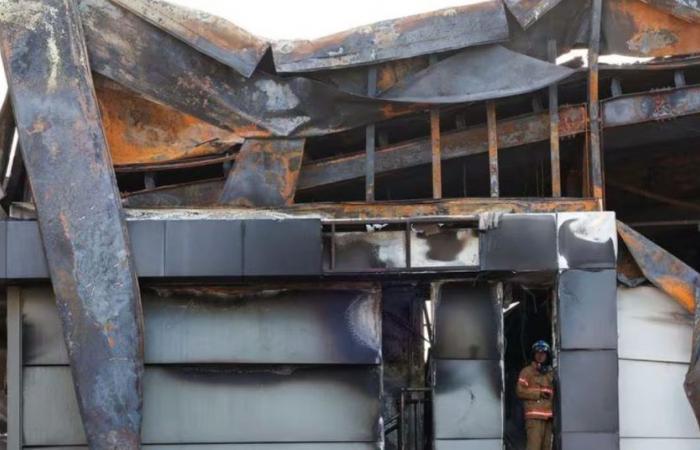SEOUL – For makers of smartphones, power grids and electric vehicles, lithium – the lightest metal – allows for more powerful batteries, bolstering hopes for a greener economy and longer-lasting devices.
But the same characteristics that make lithium a game-changer for energy storage can pose serious problems if the batteries catch fire. Lithium battery fires are becoming more common around the world, raising safety concerns.
According to firefighting experts, water is not always an effective means of fighting certain types of fires caused by lithium batteries, so there is no choice but to wait out time or use expensive extinguishing media. Fighting lithium battery fires can be difficult due to the emission of toxic gases. And then there’s the heat: Lithium produces searing temperatures more like those of a welding torch than a normal fire, capable of passing through protective equipment or a limb.
The world witnessed the risks of lithium battery fires on Monday in South Korea, where at least 23 workers died in one of the country’s worst industrial accidents in memory. Local investigators are still determining the exact cause of the fire. It is believed that some 35,000 batteries were stored on siteand video footage of the fire showed occasional flashes that produced thunderous booms, like the detonation of a bomb.
On Tuesday, Park Soon-kwan, CEO of battery maker Aricell, apologized for the incident. He added that the company had taken all necessary safety and training measures, and would fully cooperate with authorities. Local police later charged Park, along with four other company officials, with causing death and injury through professional or gross negligence. Aricell had no comment.
Kim Young-suk, owner of a beef bone soup restaurant across from the Aricell factory, heard a loud explosion at around 10:30 a.m. Monday, followed by a hiss of heat that hit the surrounding area. Dense smoke rose into the sky. Metal debris flew from the two-story building. The windows of the neighboring fishing appliance store were shattered.
Kim rushed to turn off the restaurant’s gas valves, locked the door and fled the scene. She did not reopen on Tuesday. “It was very, very scary,” she said. “We couldn’t stay there because of the fire,” she said.
Battery fires are a growing concern for firefighters around the world, prompting calls for regulation and public education campaigns. The so-called lithium-ion batteries, rechargeable and widely used in smartphones, computers and electric vehicles, are the cause of most of these fires, often due to overheating. But the South Korean factory fire affected “primary lithium” batteries, which are not rechargeable and are often used in smart grids and military equipment.
For example, extinguishing a fire in a lithium-ion battery in an electric vehicle requires more time and three times the amount of water than in a normal vehicle, in addition to exposure to carcinogenic chemicals, explains Greg McConville, national secretary. of the Australian Firefighters Union. The ignition of the fire is more intense than that of an oxyacetylene torch, which can reach about 5,000 degrees Fahrenheit or more, or about five times hotter than many home fires.
“It will literally cut through the firefighter’s protective clothing and leg if he gets out from under his vehicle,” McConville warned.
Sometimes the safest option is to let a battery fire burn. That was the case in 2021, when a Tesla battery caught fire while being installed at an Australian energy storage facility. The fire spread to another battery. Responders let the flames burn out for six hours, while they kept nearby units cool. There were no injuries.
Water, in some cases, could even make a battery fire worse, as it could produce explosive chemical reactions because lithium metals react violently to moisture, said Sunnie Haam, a professor of fire protection engineering at the University of Seoul. Coolants, such as liquid nitrogen, could be used instead of water, but it is very expensive for each fire station to purchase it in large volumes and deploy it in quantities sufficient to extinguish a large-scale fire, Haam acknowledged.
“I don’t think there is any fire station in the world with enough supplies,” Haam said.
In his assessment of South Korea’s response on Monday, Haam thought it was a wise decision to wait for the flames to extinguish themselves. Firefighters used water once it was deemed safe to do so, and then quickly began rescue operations, Haam said.
According to Tak Yong-sug, a professor of chemical engineering at Inha University in South Korea, who specializes in battery materials research, lithium is considered one of the main energy sources of the future, given its extraordinary ability to retain large quantities. of energy compared to other metals. The properties of lithium that make it suitable for energy storage also pose risks, but the metal in its various forms has been harnessed to function safely for various uses, Tak said.
“Lithium is a sought-after resource, and countries around the world are striving to ensure access to its supply,” Tak said.







